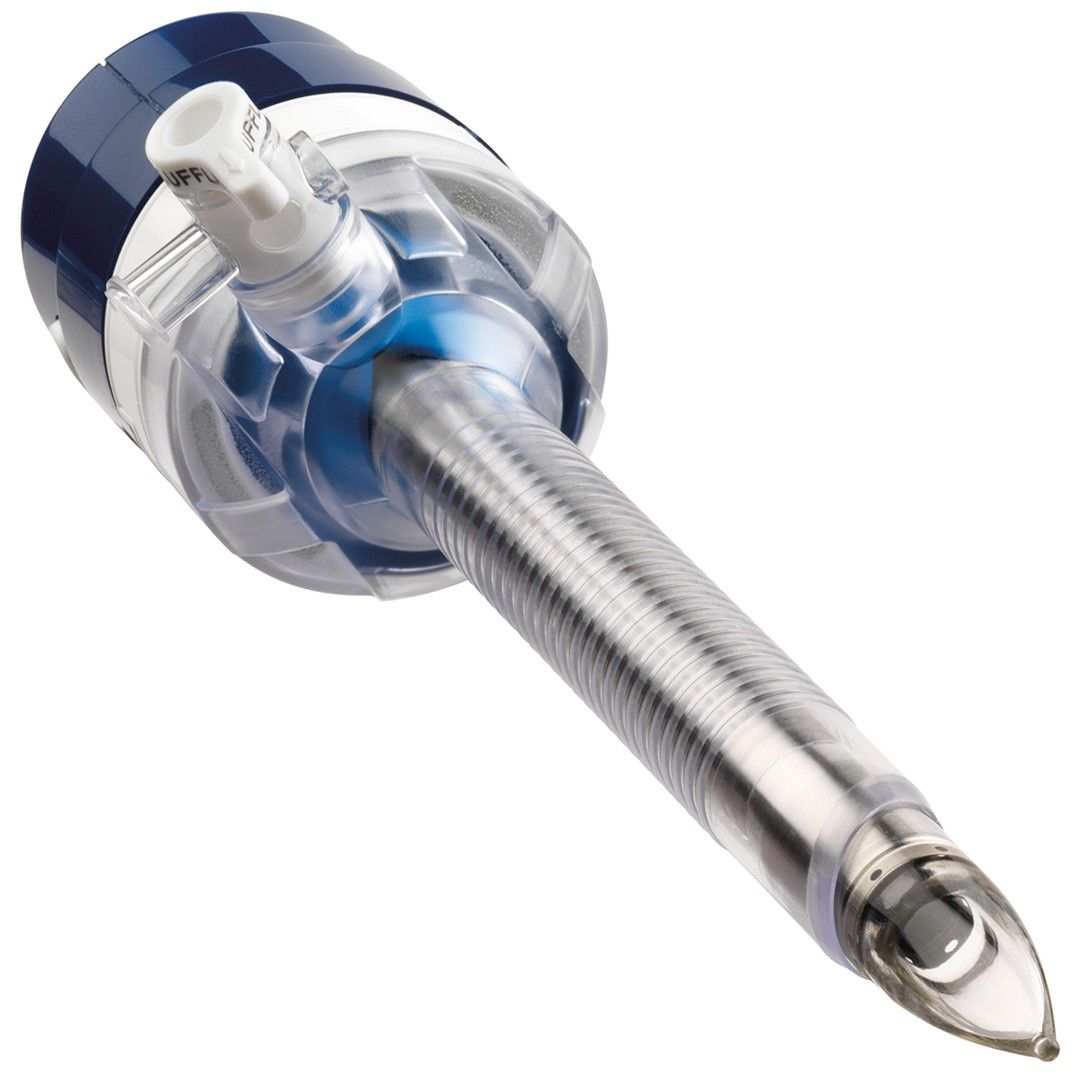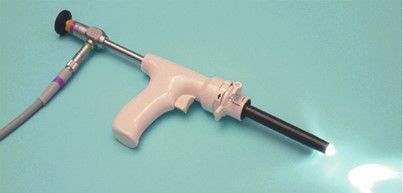Laparoscopic Visual Entry Technique
The visual entry technique accesses the abdominal cavity with a specialized optical port that has a transparent tip, allowing each layer of the abdominal wall to be seen with a 0-degree laparoscope as it is being traversed. Commercially available optical trocar/ports include Optiview, Kii optical access system, and Visiport. The way each of these devices affects tissue dissection as the tip advances differs in minor ways. These devices are typically used for primary port placement after Veress needle abdominal insufflation or secondary port placement after pneumoperitoneum has already been established.

Optical Trocar

Visiport
Open Fielding Technique
This technique developed by Fielding in 1992 involves a small incision over the everted umbilicus at a point where the skin and peritoneum are adjacent. Fielding technique is useful in patients with abdominal incisions from previous surgery provided there is no midline incision, portal hypertension and recanalized umbilical vein, and umbilical abnormalities, such as urachal cyst, sinus or umbilical hernia. Thorough skin preparation of the umbilicus is carried out and the everted umbilicus is incised from the apex in a caudal direction. Two small retractors are inserted to expose the cylindrical umbilical tube running from the undersurface of the umbilical skin down to the linea alba.
This tube is then cut from its apex downwards towards its junction with the linea alba. Further, blunt dissection through this plane permits direct entry into the peritoneum. Once the peritoneal cavity is breached, the primary port can be inserted directly, and insufflation started. A blunt internal trocar facilitates the insertion of this port and an external grip that can be attached to the port assist to secure it in position. A suture is usually not required to prevent gas leakage because the umbilicus has been everted so the angle of insertion of the laparoscopic port becomes oblique and the incision required is relatively small. However, one may be needed to stabilize the port.
The Scarred Abdomen
Additional precautions are necessary during the access procedure in patients with abdominal scars. It may be inadvisable to insert the Veress needle below the umbilicus in a patient with a scar in this area (or an umbilical hernia). Insufflation through unscarred such as the subcostal region, or if this is scarred, the iliac fossae is better. A general guideline is to choose the quadrant of the abdomen opposite to that of the scar.
Contraindications of Umbilical Entry
• Previous midline incision
• Portal hypertension with recanalized umbilical artery with advanced cirrhosis of the liver
• Umbilical abnormalities viz. urachal cyst, sinus, hernia.
The visual entry technique accesses the abdominal cavity with a specialized optical port that has a transparent tip, allowing each layer of the abdominal wall to be seen with a 0-degree laparoscope as it is being traversed. Commercially available optical trocar/ports include Optiview, Kii optical access system, and Visiport. The way each of these devices affects tissue dissection as the tip advances differs in minor ways. These devices are typically used for primary port placement after Veress needle abdominal insufflation or secondary port placement after pneumoperitoneum has already been established.

Optical Trocar

Visiport
Open Fielding Technique
This technique developed by Fielding in 1992 involves a small incision over the everted umbilicus at a point where the skin and peritoneum are adjacent. Fielding technique is useful in patients with abdominal incisions from previous surgery provided there is no midline incision, portal hypertension and recanalized umbilical vein, and umbilical abnormalities, such as urachal cyst, sinus or umbilical hernia. Thorough skin preparation of the umbilicus is carried out and the everted umbilicus is incised from the apex in a caudal direction. Two small retractors are inserted to expose the cylindrical umbilical tube running from the undersurface of the umbilical skin down to the linea alba.
This tube is then cut from its apex downwards towards its junction with the linea alba. Further, blunt dissection through this plane permits direct entry into the peritoneum. Once the peritoneal cavity is breached, the primary port can be inserted directly, and insufflation started. A blunt internal trocar facilitates the insertion of this port and an external grip that can be attached to the port assist to secure it in position. A suture is usually not required to prevent gas leakage because the umbilicus has been everted so the angle of insertion of the laparoscopic port becomes oblique and the incision required is relatively small. However, one may be needed to stabilize the port.
The Scarred Abdomen
Additional precautions are necessary during the access procedure in patients with abdominal scars. It may be inadvisable to insert the Veress needle below the umbilicus in a patient with a scar in this area (or an umbilical hernia). Insufflation through unscarred such as the subcostal region, or if this is scarred, the iliac fossae is better. A general guideline is to choose the quadrant of the abdomen opposite to that of the scar.
Contraindications of Umbilical Entry
• Previous midline incision
• Portal hypertension with recanalized umbilical artery with advanced cirrhosis of the liver
• Umbilical abnormalities viz. urachal cyst, sinus, hernia.





